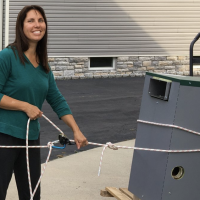Are boiler rooms dangerous? this weeks video

In this weeks video, I talk about three different boiler room accidents. Two of which resulted in fatalities and one with the person spending the rest of his life in a wheelchair. Boiler rooms can be dangerous. Dangerous boiler room.
Boiler Lessons
Comments
-
Dah!
Why do you think they keep the door locked to the boiler room at the elementary school?
If it was not dangerous, the kids would be allowed to play there at recess.
They don't even have monkey bars at the school playground anymore. And those pipes didn't even get hot! (until summer when school was closed 🤪)
Edward Young Retired
After you make that expensive repair and you still have the same problem, What will you check next?
0 -
I heard of a famous one years ago (the 50s I think) was at Bell Telephone in NY someplace. I think the cause was someone had blocked the FA intake and the boilers were gas. Someone entered the boiler room and the boilers were starved for combustion air. When he opened the door there was a huge firebox explosion. The boiler went through the boiler room wall and into the cafeteria.
After that for years Bell Telephone would not allow gas in there buildings except for the gas pilot. Don't know how true it is but that is what I heard.
I had one myself the last year before I retired on a call on a boiler we had never worked on before. A 15 psi Burnham Steel boiler. The boiler was running when I got there at 12 psi. I started setting up my analyzer and when I walked back to the front of the boiler it had 25 psi on the gauge. Not only was the safety valve rusted shut from leaking but 3 steel pigtails for the operating, modulating and high limit controls were plugged up.
1 -
-
In my 35+ years as a boiler service / installation tech for a company in Pittsburgh, Pa. I was involved in a few furnace/boiler explosions. A state inspector who carried license's for Pa and also for the Hartford Steam Boiler Inspection and insurance company now part of Munich Re, told me " a fuel explosion is called a furnace explosion and a failure of the pressure vessel is a boiler explosion". Take a look at the boiler explosion at the Dana Plant in Paris, Tn. This will give you a look into a poorly maintained steam boiler plant. I was involved in an explosion at a now closed hospital in Newcastle, Pa, a building in Greensburg, Pa. , a high school located south of Pittsburgh and a few others. I knew the dangers of working with these potential bombs and it did not frighten me. I learned to respect them. A well,maintained boiler and system will "purr like a kitten" and is always 99% safe. I like @EBEBRATT-Ed heard about the explosion in the Bell Telephone Building and met a man who worked there.
1 -
The Pilots are for Flying the Air Mail. Or is that the Post Office's job?
Edward Young Retired
After you make that expensive repair and you still have the same problem, What will you check next?
0 -
-
Many articles on the internet and some U tube videos as well about the Bell Telephone boiler explosion. Around 22 people died. 1962
21 DIE INBOILEREXPLOSIONNEW YORK, Thursday (A.A.B.).A boiler explosion 111 a New York telephone company building yesterday killedat least 21 people.Rescue workers are stillreaching ruins of the building for bodies.The 10 by 6 ft. steam boilershot through a wall into acafeteria adjoining theboiler room in the basementof the two-storey building.About 100 women employees were eating theirlunch in the cafeteria as jtheboiler burst into the room.§ispei*liea£edFire Commissioner Edward Thompson said theboiler "blew" because it wassuperheated. |"It was due probably to Jfailure of the automatic devices which regulate the waterlevel," he said.New York City buildingcommissioner, Mr. HaroldBirns said, "It was fired offlike a gun . . . like the trajectory of a shell . . . just like itwas catapulted across thebasement."It was propelled by tremendous force beyond comprehension."Clerks, secretaries andexecutives sitting at theirdesks were hurled into thebasement as the floor collapsed beneath them.More than 500 "persons, 425of them young women, werein the building.200 Feet,An eyewitness said, "Girlscollapsed where they were.Others came walking out ofthe building in shock andjust wandered off, dazed."Mr. Thompson said theblast lifted the boiler, whichweighed more than a ton, andsent it crashing through thewall of the boiler room andinto the cafeteria on the samelevel."From there, the boilertook an upward path,smashed into a supportingcolumn, and knocked downpart of the ceiling," he said."It turned downward, flew across the 100 ft. cafeteria and through a second wall into a records room-200 ft.away from its position in the 1boiler room."
0 -
The reason I remember the Bell Telephone thing is that around here oil to gas conversions were running rampant in the late 70s due to the oil embargo.
We were a sub for a large mechanical contractor at the Bell Telephone building. We sold and installed a 10,000 gallon oil tank and the subject came up why not gas??
In the middle of the job the Mechanical went bankrupt and never paid us for the oil tank and install which at that time was like 15K.
My boss had to sue Bell Telephone and put a lien on the building. Took a while and my boss wasn't happy but Bell paid up even though they had paid the Mechanical contractor for the tank. We probably got nothing after the lawyer's fees.
They wouldn't accept a building with a lien on it.
0 -
Boiler mishap 40 years ago led to the creation of Hydrolevel Company
On Oct. 2, 1962, a boiler explosion claimed the lives of 21 people at a New York Telephone building in Manhattan. The disaster, caused by an undetected low-water condition, forever changed the way all steam boilers, from that point, were manufactured and installed as New York Telephone searched for better ways to protect their employees and property from such low-water conditions.
At that time, Michael DeLeonardis of Farmingdale, N.Y., was experimenting with a new electronic water level device for steam boilers. He had developed his idea in Italy, where he had trained as a steam engineer in the years before World War II. After coming to America, DeLeonardis further refined his ideas while working on shipboard steam boilers at the Brooklyn Naval Yard.A newspaper headline from October 1962 tells the story of the fateful boiler fire at the New York Telephone office in Manhattan, a disaster that led to the creation of the Hydrolevel Company.
His idea was simple but effective. Using water as an electrical conductor, he designed a control utilizing a ‘probe” sensor. The electronic control monitored the level of the boiler water without the use of moving parts that could wear and stick. A ‘time-delay” mechanism was also incorporated that allowed the probe to be used in the violent water of a steam boiler without short-cycling the burner.
DeLeonardis took the idea to New York Telephone, which recognized the advantages of the design. In 1965, his electric control was specified for all New York Telephone buildings and the Hydrolevel Comany was born.
‘There were a lot of safety concerns after the New York Telephone explosion,” said Bill Montgomery, a spokesman for Hydrolevel. ‘After that, all boilers, both residential and commercial, were supplied by manufacturers with a low-water cut-off in them. It was a big turning point in safety in steam boilers.”
But like most good stories, it was not as easy as it looked.DeLeonardis was actually born in the United States, in Fitchburg, Mass., in 1900. At age seven, his family moved to Italy to care for a sick grandfather. DeLeonardis grew up in the town of Santa De Colle, but when Mussolini came to power, the family moved back to the U.S., settling in New York.
Michael DeLeonardis’ probe-type low-water cut-off that revolutionized the safety of residential and commercial boilers.
It was while working in the Brooklyn Naval Yard in the 1950s that DeLeonardis met his future partner in Hydrolevel, Russ Rymer. DeLeonardis had bid on a Navy contract for a hydrofoil and Rymer was the inspector the Navy sent to check out DeLeonardis’ operation, which at that time included a 16,00-square-foot shop on Long Island.
As it turned out, DeLeonardis didn’t get the contract, but he did point out to Rymer a flaw in the Navy’s design for the hydrofoil, which it did, in fact, have, a fact that Rymer would not forget.
When Hydrolevel was born, DeLeonardis secured Rymer as a partner in the operation, along with his own son, Dominick. While New York Telephone opened the door to the use of the probe-type low-water cut-off, other entities soon adopted the device. Among them were the Government Services Administration in 1968 and Brooklyn Union Gas in 1971.Michael DeLeonardis’ Long Island workshop, where he developed the time-delay device that led to the creation of the probe-type low-water cut-off.
There were some, however, who were not enamored with DeLeonardis’ invention and several companies conspired with the American Society of Mechanical Engineers, convincing the code-writing agency to say that time-delays in low-water cut-off applications should not be allowed.
When DeLeonardis and Rymer got word of this conspiracy, they went to the Wall Street Journal and the articles written in the paper became the basis for a precedent-setting lawsuit against ASME that would go all the way to the United States Supreme Court. There, the court ruled in favor of Hydrolevel in a decision ‘that is still taught in engineering and engineering ethics classes today,” according to Montgomery.
The court victory did not come without a cost, however. Rymer had suffered for years with heart ailments and he was in the hospital the day the court ruled in Hydrolevel’s favor. In presenting him with the glorious news, DeLeonardis had his friend and business partner collapse and die in his arms of a heart attack. That was February 1979. Two months later, DeLeonardis himself passed away.
Forty years later, however, DeLeonardis’ inventive spirit lives on. Today, Hydrolevel, located in New Haven, Conn., offers a full line of products for boiler protection and liquid-level control. The new generation of Hydrolevel controls includes CycleGard foam-compensating cut-offs, VXT programmable water feeders and the Safgard 1100 Series ‘mini” cut-offs.1 -
I'm not sure why no one told Mr. DeLeonardis that his invention isn't useful due to the existence of the Hartford Loop. Not sure how he convinced people to buy his product.
NJ Steam Homeowner.
Free NJ and remote steam advice: https://heatinghelp.com/find-a-contractor/detail/new-jersey-steam-help/
See my sight glass boiler videos: https://bit.ly/3sZW1el0 -
@McDonnell Miller had a lot of power in the industry and still does. Not much competition. As far as HP steam they are still almost the only game in town. They probably had 95% or more of the LWCO/pump control business at one point.
Honeywell, Watts and White Rogers had LWCO but not the complete line so M/M had a monopoly on it for probably45-50 years.
Hydrolevel and MM have been in court several times over the years for various reasons.
I'll give you another example:
HB Smith used to sell tons of CI boilers especially the commercial stuff. There foundry was only 10 miles from me. We were taught in school that HB Smith was virtually the only CI boiler made!!!!! They had all the business around here and a lot of it elsewhere. There boilers had "pork chop" sections where each section was an individual boiler. They had external headers steam on top and 1 on each side for the water. Because the sections could be disconnected from the headers and plugged one of there selling points was if you lost a section due to cracking etc you could disconnect that section and keep running the boiler.
Starting in the 70s and 80s Weil McLain (and the hated Burnham) and Peerless were pushing the new wet base CI boilers. Smith went with their old stuff (the nipples and gaskets between the sections and the headers were a PITA and needed maintenance every few years) so as a result they started to loose market share at the wet base boiler were easier to install.
Because they didn't change with the times they are basically history now.
There old header type boilers were good boilers and lasted and had good efficiency but needed maintenance. They didn't change fast enough with the times.
0 -
Check out the Ford Rouge boiler explosion. I think this was a driving force for CSD-1. Years after working at Ford plants or properties they required extra safeties for all gas trains on RTUs and and gas fired equipment. The powerhouse sat idle for years due to litigation.
Owner of Grunaire Climate Solutions. Check us out under the locate a contractor section. Located in Detroit area.
0 -
The owner of my old boiler service company, taught me a great deal about our HPS system at work. I gave a group tour through the CUP and told him a lot of people were nervous being in there. It was loud.
He said something that always stuck with me: If this equipment is always well maintained- it will always be the safest room in the building.
0 -
I wouldn't say safest room in the building but think about the thousands of boilers installed. Very few serious accidents.
0 -
I would because they can be.
There are safeties, and on HPS, redundant safeties. In this state, the boilers are torn down, cleaned, inspected by a state inspector, and restored with new gaskets, site glasses, LWCO and HWCO probes annually. Then, a combustion analysis. All issues are dealt with and safeties are tested daily. Any issues and the boiler is locked out then isolated for repairs. And staff are trained on boiler controls. That is probably the most critical, followed by a budget that can support the philosophy and a management not prone to taking short cuts.
So, my mentor was right- if well maintained, the boiler room is the safest room.
I cant think of an incident where a lack of training, a lack of maintenance, a lack of money and/or lack of management support wasn part of the root cause of an incident.
1
Categories
- All Categories
- 87.3K THE MAIN WALL
- 3.2K A-C, Heat Pumps & Refrigeration
- 61 Biomass
- 427 Carbon Monoxide Awareness
- 119 Chimneys & Flues
- 2.1K Domestic Hot Water
- 5.8K Gas Heating
- 115 Geothermal
- 165 Indoor-Air Quality
- 3.7K Oil Heating
- 76 Pipe Deterioration
- 1K Plumbing
- 6.5K Radiant Heating
- 395 Solar
- 15.6K Strictly Steam
- 3.4K Thermostats and Controls
- 56 Water Quality
- 51 Industry Classes
- 50 Job Opportunities
- 18 Recall Announcements





